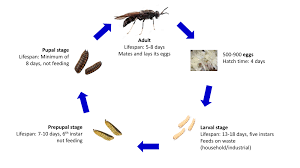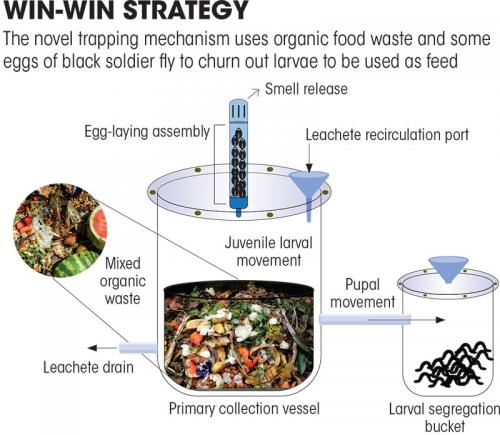Black Soldier Fly Larvae and Poultry Feed | 14 Feb 2023
Why in News?
India is among the top five chicken and egg producers in the world, but there are challenges to the business for small poultry farmers because of the quality, quantity and cost of feed.
- Black soldier fly, since it has a high nutritional value can be one of the substitutes to address these challenges.
What are the Challenges Related to Poultry Feed?
- Feeds account for up to 70% of the entire cost of poultry production. Besides, the conventional feed supplied to the poultry, majorly cereals and soya, competes with the food demands of a growing human population.
- In addition to rising cost, the feed resource availability is a major determinant of the sustainability of the poultry sector.
- One such alternative is brewers dried grains, a byproduct of the brewing industry.
- Though rich in protein and amino acid, its limitations include high moisture and fibre content.
- Rice bran is another economically viable alternative to wheat in certain parts of the country. It has a comparable apparent metabolisable energy as wheat.
- However, studies show that the laying performance of the chicks declined on incorporation of rice bran to the feed.
- The larvae of black soldier fly (Hermetia illucens), for instance, have a high nutritional value and are easy to raise.
What is Black Soldier Fly?
- About:
- The black soldier fly is a fly (Diptera) of the Stratiomyidae family that is commonly found in many parts of the world.
- They are a dull, whitish color. They feed on a variety of organic matter, from rejected food waste to manure.
- They also have high waste-to-biomass conversion efficiency.
- This means, unlike hot-blooded mammals and birds, which use a lot of energy to keep themselves warm, insects are efficient converters of food into body mass.
- Utility:
- They can be a low-cost, low footprint, eco-friendly as well as natural feed companion to poultry farmers.
- The larvae are capable of converting the organic waste into a wide range of useful vitamins and minerals.
- They are thus rich in calcium, phosphorus, magnesium, sodium, potassium, iron, zinc, copper, manganese and so on, which makes them a promising candidate for livestock feed.
UPSC Civil Services Examination, Previous Year Question (PYQ)
Q. Consider the following statements: (2019)
- Agricultural soils release nitrogen oxides into environment.
- Cattle release ammonia into environment.
- Poultry industry releases reactive nitrogen compounds into environment.
Which of the statements given above is/are correct?
(a) 1 and 3 only
(b) 2 and 3 only
(c) 2 only
(d) 1, 2 and 3
Ans: (d)


